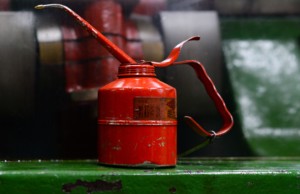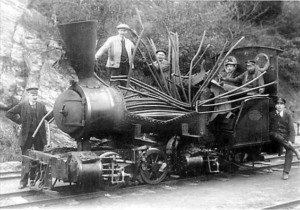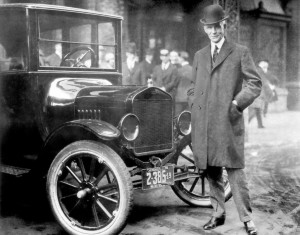 At the suggestion of multiple readers, I would like to take a deeper look into maintenance, especially total productive maintenance (TPM). Maintaining your machines and tools is important for your business. In many places, maintenance seems to be more reactive: if it breaks, fix it. Often, a better approach would be proactive maintenance: maintain it so it doesn’t break in the first place. In this first post in this series of articles on maintenance, I would like to look a bit into the history of maintenance. Subsequent posts will look deeper into why we need to maintain our stuff and how to do it. The overarching theme is guided by total productive maintenance, but I won’t hesitate to give my critical opinion where necessary.
At the suggestion of multiple readers, I would like to take a deeper look into maintenance, especially total productive maintenance (TPM). Maintaining your machines and tools is important for your business. In many places, maintenance seems to be more reactive: if it breaks, fix it. Often, a better approach would be proactive maintenance: maintain it so it doesn’t break in the first place. In this first post in this series of articles on maintenance, I would like to look a bit into the history of maintenance. Subsequent posts will look deeper into why we need to maintain our stuff and how to do it. The overarching theme is guided by total productive maintenance, but I won’t hesitate to give my critical opinion where necessary.
Pre-Industrial Corrective Maintenance
 For most of our industrial history, maintenance was simple. When it broke, you fixed it. Maintenance was purely reactive. This is called corrective maintenance or, for more drastic failures, sometimes emergency maintenance. For most pre-industrial management, this was fine. If something broke, then the customer just had to wait longer for its product. Very few businesses had anything even remotely similar to what we see as maintenance nowadays. One of the few exceptions was the Montgolfier paper mills, which started to employ regular maintenance, including cleaning of the tools, around 1800. They used thirty-five days per year for maintenance. The family is more famous, however, for inventing the hot air balloon.
For most of our industrial history, maintenance was simple. When it broke, you fixed it. Maintenance was purely reactive. This is called corrective maintenance or, for more drastic failures, sometimes emergency maintenance. For most pre-industrial management, this was fine. If something broke, then the customer just had to wait longer for its product. Very few businesses had anything even remotely similar to what we see as maintenance nowadays. One of the few exceptions was the Montgolfier paper mills, which started to employ regular maintenance, including cleaning of the tools, around 1800. They used thirty-five days per year for maintenance. The family is more famous, however, for inventing the hot air balloon.
Preventive Maintenance
 With the Industrial Revolution, maintenance became more prominent. The problem was that boilers of steam engines tended to explode, maiming or killing the workers nearby. This led to technical checks and verifications to ensure that the boiler was in a safe working condition. The German TÜV was also established after a large boiler explosion in 1865. The goal was to prevent loss of life through maintenance. But as long as they didn’t kill anybody, machines were usually fixed only after they broke.
With the Industrial Revolution, maintenance became more prominent. The problem was that boilers of steam engines tended to explode, maiming or killing the workers nearby. This led to technical checks and verifications to ensure that the boiler was in a safe working condition. The German TÜV was also established after a large boiler explosion in 1865. The goal was to prevent loss of life through maintenance. But as long as they didn’t kill anybody, machines were usually fixed only after they broke.
 As manufacturing became more and more connected, supply chains more complicated, and product varieties increased, breakdowns of machines led to many (and expensive) follow-up problems. The idea to fix machines before(!) they broke appeared, and preventive maintenance (PM) (or planned maintenance) was born. Henry Ford used it extensively in his factories and also recommended it for his car. For example, the Ford Model T manual from 1919 advises
As manufacturing became more and more connected, supply chains more complicated, and product varieties increased, breakdowns of machines led to many (and expensive) follow-up problems. The idea to fix machines before(!) they broke appeared, and preventive maintenance (PM) (or planned maintenance) was born. Henry Ford used it extensively in his factories and also recommended it for his car. For example, the Ford Model T manual from 1919 advises
Frequently inspect the running gear. See that no unnecessary play exists in either front or rear wheels and that all bolts and nuts are tight. Make a practice of taking care of every repair or adjustment as soon as its necessity is discovered. This attention requires but little time and may avoid delay or possible accident on the road.
The challenge here is that there are numerous possible failures. It may be impossible, or at least financially insensible, to prevent them all. It would be better to prevent only the problems that are likely to happen, but then you would need to know which problems are likely to happen. The question of what to maintain, how to maintain, how often to maintain, which spare parts to stock, and so on still challenges maintenance to this day.
Maintenance Becomes Buzzwordy
 War is the driver of many inventions, and maintenance of aircraft and other gear during World War II became more prominent. In the years after World War II, a whole flurry of terms related to maintenance appeared. Corrective Maintenance appeared in 1957, maintenance prevention (not to be confused with preventive maintenance) appeared in 1959, and productive maintenance appeared in 1961. In the US airline industry, reliability centered maintenance (RCM) was also developed, but is less known nowadays. The overarching term proactive maintenance is also sometimes used. There are some minor differences between the meanings of these terms, but to me they all feel the same, and the difference may be more of a way to sell consulting to clients rather than differences in actual maintenance.
War is the driver of many inventions, and maintenance of aircraft and other gear during World War II became more prominent. In the years after World War II, a whole flurry of terms related to maintenance appeared. Corrective Maintenance appeared in 1957, maintenance prevention (not to be confused with preventive maintenance) appeared in 1959, and productive maintenance appeared in 1961. In the US airline industry, reliability centered maintenance (RCM) was also developed, but is less known nowadays. The overarching term proactive maintenance is also sometimes used. There are some minor differences between the meanings of these terms, but to me they all feel the same, and the difference may be more of a way to sell consulting to clients rather than differences in actual maintenance.

The idea of productive maintenance reached Japan after World War II. At this time, a lot of industrial ideas from the US fell on fertile ground in Japan, like Training within Industry, or Deming’s quality circles, and were improved upon. Productive maintenance, too, turned into total productive maintenance (TPM) in 1969. The key driver behind this development was Seichi Nakajima, who learned about productive maintenance in the USA and in Europe. He developed TPM together with the Japan Institute for Plant Maintenance (JIPM). The motto is “Protect your machine and take care of it with your own hands.” The same acronym is also sometimes written as total preventive maintenance, but this seems to be not a different set of tools but merely a confusion of the many different terms.
 At the same time, maintenance for most companies was still mostly reactive and not very organized. Only between 1960 and 1980 did maintenance become more prominent and structured. Around this time, norms for maintenance were established, together with the sale of certificates.
At the same time, maintenance for most companies was still mostly reactive and not very organized. Only between 1960 and 1980 did maintenance become more prominent and structured. Around this time, norms for maintenance were established, together with the sale of certificates.
Predictive Maintenance
 Finally, with industry 4.0, predictive maintenance (PdM 4.0) emerged, trying to… well … predict the problem before it happens. The idea is to collect lots of data (buzzword: big data) and have algorithms and AI’s look for patterns to predict upcoming problems and permit maintenance to fix the problem before it happens. As such, it is also a proactive maintenance, but with the idea to reduce excessive maintenance though a better understanding of the system.
Finally, with industry 4.0, predictive maintenance (PdM 4.0) emerged, trying to… well … predict the problem before it happens. The idea is to collect lots of data (buzzword: big data) and have algorithms and AI’s look for patterns to predict upcoming problems and permit maintenance to fix the problem before it happens. As such, it is also a proactive maintenance, but with the idea to reduce excessive maintenance though a better understanding of the system.
Total productive maintenance (TPM) is currently the most popular one, although I have a feeling that there will be even more buzzwords in the future. Overall, there are a lot of buzzwords trying to address the problem of maintenance from different angles.
In my next post I look at the different reasons why you should maintain your equipment. There is more to this than just “uptime.” More posts on maintenance, especially total productive maintenance (TPM) will follow. Now, go out, keep your gear in good running order, and organize your industry!
Series Overview
- A Brief History of Maintenance
- What Are the Goals of Maintenance?
- An Overview of the Eight Pillars of Total Productive Maintenance
- The Pillars of TPM – Focused Improvement
- The Pillars of TPM – Autonomous Maintenance
- The Pillars of TPM – Planned Maintenance
- The Pillars of TPM – Early Equipment Management
- The Pillars of TPM – Quality, Training, Administration, and Safety
- The Pillars of TPM – The Missing Pillar Reactive Maintenance?
Selected Sources
Peter Poór, David Ženíšek, Josef Basl, “Historical Overview of Maintenance Management Strategies: Development from Breakdown Maintenance to Predictive Maintenance in Accordance with Four Industrial Revolutions”, Proceedings of the International Conference on Industrial Engineering and Operations Management Pilsen, Czech Republic, July 23-26, 2019

I find Condition Monitoring critical. Whether this might be stand-alone or a sub-set of something else doesn’t really matter – as long as it gets done! Whilst Preventive Maintenance is fine, there’s often an element of excess in there. For example PM might suggest ‘change the oil every x months or y miles’. With condition monitoring one changes the oil when necessary.
Hi Steve, totally agree. monitoring is often very helpful to prevent breakdowns.
Nice Article on Maintenance…
Equipment use contributes to wear and wear generally increases tolerances over time. These tolerances can be measured and monitored thereby contributing to a preventative or proactive maintenance program. The intent is to maintain quality within standards and prevent more costly repairs due to equipment failure. It is interesting to perform root cause analysis on equipment failures and quality rejects – often times the appropriate countermeasures are preventative maintenance.
Great post Chris, During world war maintenance was a huge deal considering that they needed as many weapons available at all times. One thing that I wondered while reading this post about the world wars is what country do you think excelled the most in vehicles and on maintenance? One might think it would be Germany since they are considered great engineers. Were they better prepared than say the US?
Hi Jason, in the US maintenance was an important topic. I am not so sure about the other countries. I just know that Germany had problems because of raw material shortages. For example tank gears failed since we could not get chromium for high class steel.
Hello Dear Professor,
Thanks a lot for the post, I look forward to the next one in the series.
As always these teach a lot and open the minds of readers.
Great post Chris,
Yes as u rightly mentioned maintenance evolved over a period of time from reactive to proactive maintenance.
There is also one more classification we talk about is Time based and condition based maintenance. Deciding the degree of maintenance is crucial for balancing plant availability and maintenance costs.
Looking forward to here from u more on maintenance.